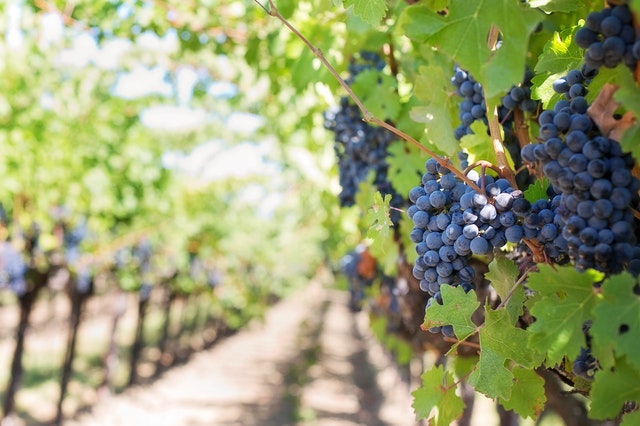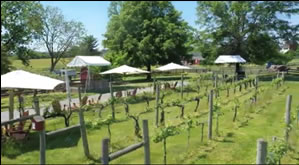
Wine at Shiloh Manor Farm
Fall means many things at Shiloh Manor Farm in Loudoun County, VA. The still warm September sun is setting lower in the sky, the grass slowing down and the vinifera grapes in our vineyard warming to a deep purple blue in the afternoon sun.
At Shiloh Manor Farm we have 100 vines that produce wine, grape jelly and unfermented grape juice for our use. We are not licensed to sell our wine yet, but our goal is to obtain a license to market our wine in the future to our friends and guests.
On the surface, winemaking looks simple enough: you grow than gather grapes, throw them in a tank, and then wait. After some time has passed, “voila!” You have wine.
In truth, winemaking is an arduous process of observations, sanitization, and a complex and rather unforgiving set of practices, all for the purpose of shepherding billions of microbes through the bewildering process of fermentation. All grape juice will ferment, but not all fermented grape juice is good wine!
In this blog I want to describe what it takes to produce a glass of wine!
It all begins with the grapes. Grapes have been cultivated for thousands of years but there is still a lot of mystery to producing high quality grapes.
Growing grapes involves a complex interaction between the sun, soil topology, and climate.
Soil influences how much water and heat are available to the vines. Dark soils tend to be warmer than light soils because they are better at absorbing and holding heat. The compact, red clay soil we have in Virginia is less than idea because it keeps water from draining and grapes dislike wet feet. Too much nitrogen in the soil promotes leaf growth, which is good, but too much leaf canopy creates excessive shade that delays ripening and inhibits airflow – leading to fungal disease. Too little potassium makes plants vulnerable to drought and disease and yields grapes that are low in sugar.
Topography influences the amount of sunlight available, soil characteristics, drainage and airflow. You generally want your grapes rows to run north-south so the rows get maxima exposure to sunlight. It also promotes airflow through the canopy. Vinifera grapes originate in the France and Italy, in a generally hot and dry climate. In the right environment grape vines can live hundreds of years. But northern Virginia is borderline for growing French vinifera grades like Cabernet Sauvignon and Cabernet Franc, an excessively cold winter can be deadly for even cold hardy vines. The humidity of Northern Virginia also creates a perfect environment for mildew and fungal infections that can ruin a harvest in just a few days of inattention.
After their long winter rest, the vines begin to awaken in late April. After months of careful pruning and checking for disease and spraying as needed harvest comes in late September or early October. We time harvest based on the sugar content of the grape, ideally looking for about a 14% sugar content. The sugar is important because in fermentation the natural sugar of the grape is converted to alcohol. Ideally you want a wine with about an 11% alcohol content, less than that doesn’t keep well, and more than that level imparts a hot taste to the wine which is not desirable.
Harvesting grapes is hard work! Commercial growers use heavy machinery but that is not practical for our small vineyard, so we harvest the old fashion way… by hand. Our 100 vines in our vineyard, producing about 800 pounds of grapes! Fortunately, we are blessed to have many willing and able friends to lessen the load!
 After harvesting the next step is crushing and destemming. In centuries past, that was done manually, but today we use an electric crusher-destemmer. Like all red wine, the crushed grapes are fermented with the skin and seeds and some stems to add tannins and phenolics. The juice and grape must is transferred to a fermentation tank which is where the magic occurs. Traditionally wine would be fermented in oak barrels for large clay tanks, but at Shiloh we ferment in a stainless-steel tank.
After harvesting the next step is crushing and destemming. In centuries past, that was done manually, but today we use an electric crusher-destemmer. Like all red wine, the crushed grapes are fermented with the skin and seeds and some stems to add tannins and phenolics. The juice and grape must is transferred to a fermentation tank which is where the magic occurs. Traditionally wine would be fermented in oak barrels for large clay tanks, but at Shiloh we ferment in a stainless-steel tank.
Fermentation required two ingredients, grape juice and yeast.
Yeast grows naturally on grapes, but the strains of yeast found in America produce off flavors when used to ferment French grapes. So we inoculate the must with imported dry French yeast strains. Red wines ferment hot at about 80 or 90 degrees. While the wine is fermenting, carbon dioxide is released, which causes grape seeds and skins to rise to the surface. We punch down the “cap” twice a day to ensure all the color and flavors are extracted. During this time, we frequently sample the fermenting must and measures the pH or acid levels and adjust as necessary.
After about two weeks the fermentation is runs to completion and the wine grows “still”. That is the time to press the wine out of the skins and seeds. At Shiloh we use a small hydraulic screw press. The wine is collected and goes into 6-gallon glass jugs called carboys. This is the stage that the French call “élevage” or “waiting around.” Why are we waiting? For all the sediment and dead yeast to settle at the bottom of the carboy. Typically, this takes about three months (nothing happened fast in wine making). After a thick layer of sentiment is settled on the bottom of the glass carboy, the wine is syphoned out and placed in an oak barrel.
Why oak? Because it imparts a particular flavor to the wine by adding tannins. Not all oak is created equal. French oak can give the wine a subtle spice, while American oak can give off hints of vanilla. Because oak barrels are porous, they also allow small amounts of oxygen to dissolve in the wine. This softens the harsh textures of the tannins and gives a smooth, oaky flavor.
Typically, a wine rests in oak for three to six months, after which it is again racked and placed back into a 6-gallon glass carboy to bulk age, usually for a few years. We sample the wine periodically for off flavors, especially acetic acid (or vinegar) and hydrogen sulfite – a rotten eggs smell that can come from agricultural sulfur applications used to prevent or treat fugal disease in the developing grape. The desired pH of the wine is about 3.6 so sometimes we blend different years together to normalize out higher or lower acidity that varies with the growing season, harvest time and grape quality.
The last step is manually syphoning the wine one more time into sterilized wine bottles. These are corked using a compression corker and aged for a least another year before its ready to drink.
 So next time you have a glass of wine with friends or dinner think about the magic of fermentation, the huge amount of year-to-year variability in grape quality and the loving attention of the winemaker. Psalm 105:15 in the Bible says, “Wine maketh glad the heart of man…”
So next time you have a glass of wine with friends or dinner think about the magic of fermentation, the huge amount of year-to-year variability in grape quality and the loving attention of the winemaker. Psalm 105:15 in the Bible says, “Wine maketh glad the heart of man…”
